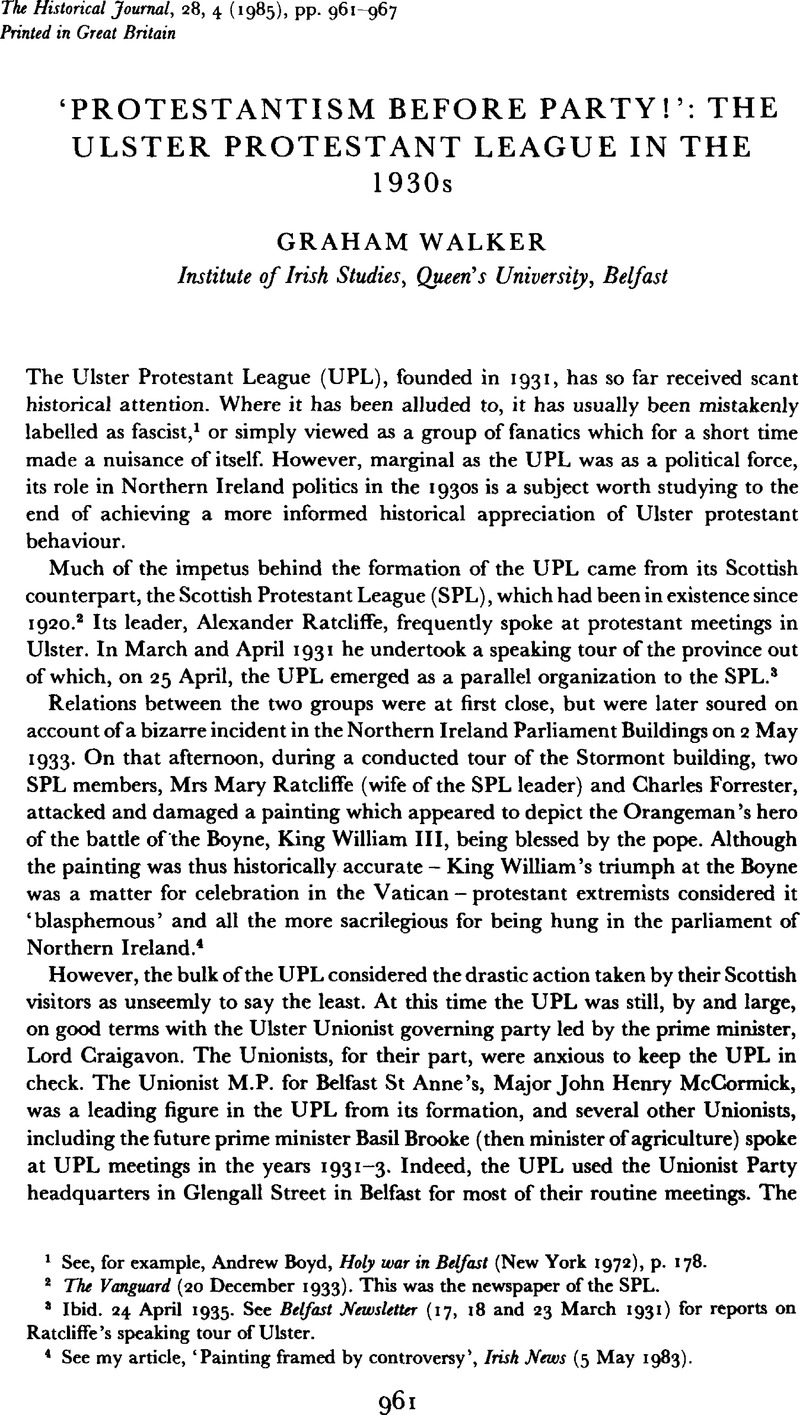Published online by Cambridge University Press: 11 February 2009

1 See, for example, Boyd, Andrew, Holy war in Belfast (New York 1972), p. 178Google Scholar.
2 The Vanguard (20 December 1933). This was the newspaper of the SPL.
3 Ibid. 24 April 1935. See Belfast Newsletter (17, 18 and 23 March 1931) for reports on RatclifTe's speaking tour of Ulster.
4 See my article, ‘Painting framed by controversy’, Irish Mews (5 May 1983).
5 The Vanguard (13 December 1933).
6 Ibid. 25 October 1933. Ratcliffe addressed the inaugural meeting of the UPS.
7 See Farrell, Michael, Arming theprotestants (Kerry, 1983), pp. 211–16Google Scholar.
8 Belfast Telegraph (28 November 1933).
9 See Northern Whig (25 May 1934).
10 See Griffiths, Richard, Fellow traellers of the Right (Oxford, 1983), pp. 92–3Google Scholar.
11 See, for example, British Fascism (October 1932).
12 The Ulster Protestant (August 1934).
13 Ibid. (February 1935)
14 See, for example, The Ulster Protestant (July 1934).
15 Ibid. (October 1939).
16 See, for example, The Ulster Protestant (December 1935). Objectively, there would seem to be little evidence to support these claims. In the case of the police force, Farrell, , Arming the protestants, p. 267Google Scholar notes that the overall proportion of catholics was 17.3% in 1927 and 17.1% in 1936. If anything, therefore, the numbers of catholic policemen slightly declined in this period. However, catholics did make up 344% of sergeants and 28.1% of head constables in 1927 (Farrell, p. 267), and the main thrust of the UPL propaganda in respect of catholic employment was not so much directed at numbers as at the seniority and importance of the jobs concerned. In the case of the civil service, the UPL propaganda was even less credible. Catholics rarely rose to senior departmental positions at this time. See the autobiography of a catholic civil servant in this period: Shea, Patrick, Voices and the sound of drums (Belfast, 1981)Google Scholar.
17 The Ulster Protestant, (July 1935).
18 Northern Ireland suffered acutely from the depression. Its traditional staple industries – linen and shipbuilding – were particularly badly hit. In 1932, for example, only two vessels were launched from the Belfast shipyards, and in 1934 the Workman and Clark yard closed down. The unemployment rate in the early 1930s averaged around 27% but this did not take account of those who were not registered as unemployed. See The Ulster Tear Books for this period.
19 Northern Ireland House of Commons Debates, XVII. 2425–6, (10 July 1935).
20 Government documents on the matter are reproduced in Hepburn, A. C., The conflict of nationality in modern Ireland (London, 1980), pp. 165–7Google Scholar.
21 See Gallagher, Tom, ‘The year Red Clydeside turned pink’, The Scotsman, 5 11 1983Google Scholar.
22 The Ulster Protestant (March 1936).
23 Belfast Telegraph (16 May 1936).
24 Ibid. (7 May 1936).
25 The Ulster Protestant (January 1938).
26 M A. Cleland for the Belfast seat of Willowfield. He was defeated by the Unionist by 7,616 votes to 4,086.
27 See Farrell, Michael, Northern Ireland: the Orange State (London, 1976), pp. 136–42Google Scholar, and Devlin, Paddy, Yes, we have no bananas (Belfast, 1981), pp. 143–4Google Scholar .